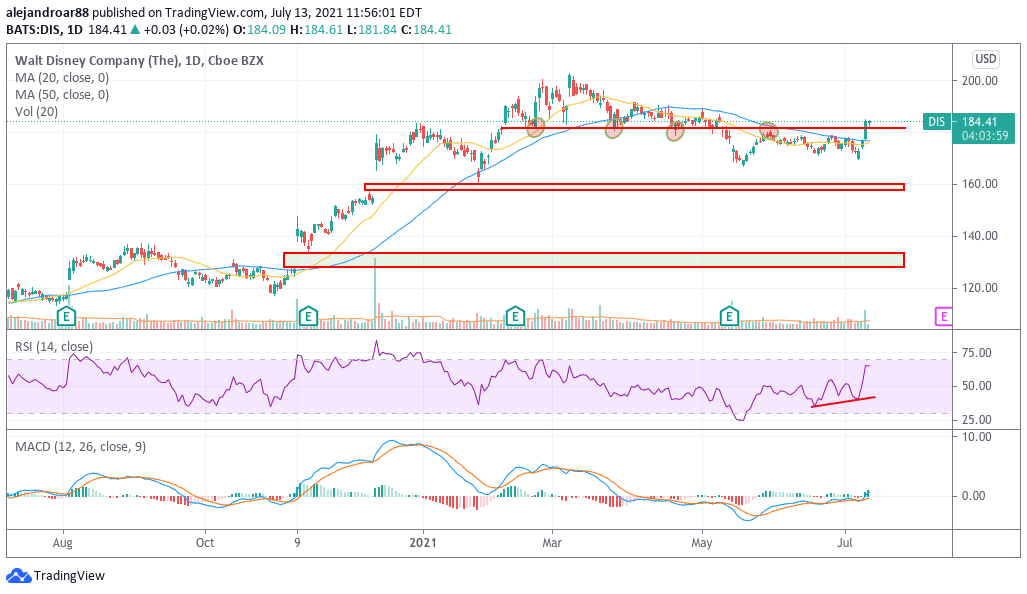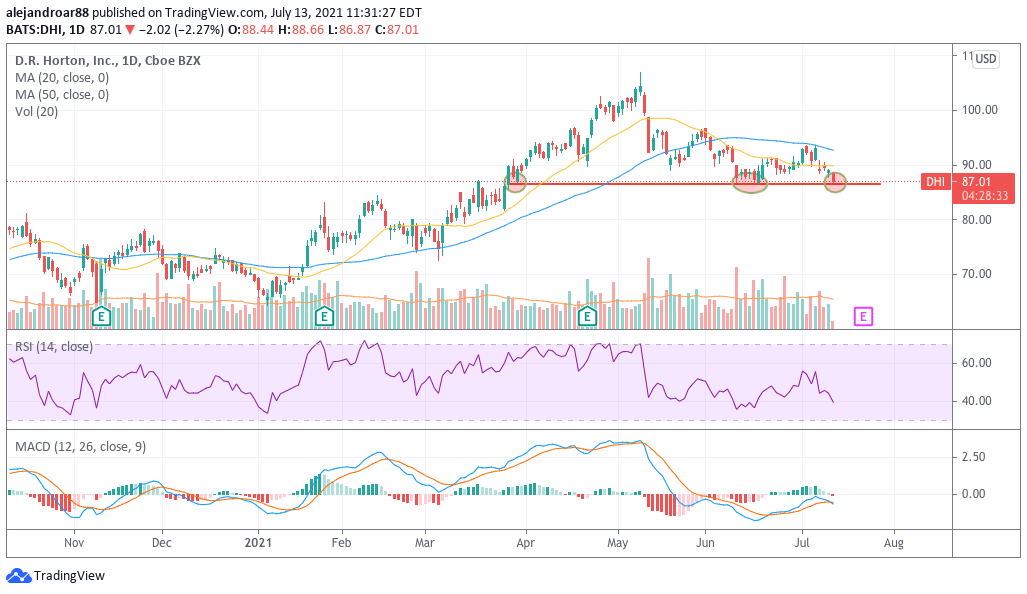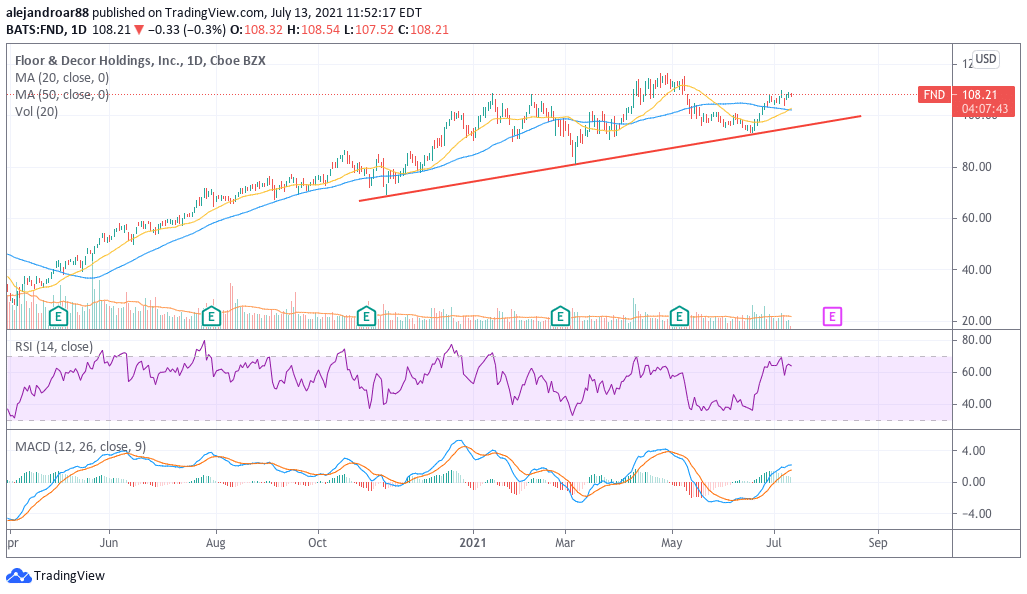5 Best Cyclical Stocks to Buy in July 2021
Please note that we are not authorised to provide any investment advice. The content on this page is for information purposes only.
With the US economy staging a strong comeback after being hit by the pandemic last year, cyclical stocks should continue to benefit from an ongoing sector rotation.
In this regard, the capital influxes received by sectors that were benefitted from the pandemic such as technology and biotech could now turn to these stocks as they should emerge as winners in a post-pandemic environment.
The following list brings up five names that you might want to consider as they display an appealing track record of revenue and profitability growth, conservatively financed balance sheets, and attractive valuations based on their growth prospects and historical performance.
1. Disney (DIS)

Disney’s exposure to the travel and leisure market hurt the firm’s top and bottom-line results last year as sales declined by more than 6% while net earnings suffered a 4% setback.
The downturn was cushioned by the company’s successful pivot toward a streaming-focused media strategy, with Disney+ already becoming an important player in this industry.
Meanwhile, as the world progressively steps out of the pandemic situation, tourists should progressively flock to Disney parks and resorts to enjoy some time off after remaining confined within their homes for months.
Analysts seem to share this view as they are anticipating that Disney (DIS) sales should already surpass pre-pandemic levels this year while estimates for the following years are seeing Disney’s top-line performance surging by around 25% compared to this year’s results.
Based on analysts’ EPS forecasts for 2022, Disney is being valued at 32 times its forecasted earnings. This multiple seems fairly conservative for a company that has multiple avenues through which it can continue to grow in the future including its brand new Disney+ revenue stream and the ongoing success of many of its film franchises.
67% of all retail investor accounts lose money when trading CFDs with this provider.
2. Deckers Outdoor Corporation (DECK)
The pandemic prompted many people in and outside the United States to go outside and enjoy nature as outdoor activities were not considered risky as long as safe distancing protocols were followed.
As a result, Decker’s revenue growth accelerated from an average of 6% in the years that preceded the pandemic to a 19% jump last year, with sales landing at $2.55 billion by the end of the firm’s 2021 fiscal year.
Meanwhile, profit margins for the firm have been progressively improving, with net margins moving from 6% in 2018 to 15% by the end of the past fiscal year.
Analysts are estimating that the firm should continue to grow at an even faster pace compared to a year ago as more people might join this trend of practicing outdoor sports. As a result, sales are expected to land 18% higher at $3 billion by the end of the current fiscal year.
Moreover, if the firm maintains its net margin as is during the current fiscal year, net income for DECK could land at around $450 million, resulting in a forward P/E ratio of 24 for a company that is expected to grow its earnings at a rate of around 10% to 20% per year.
To make things even more interesting, Decker has nearly no long-term debt and at least 5% of its current valuation is supported by the company’s cash reserves. Additionally, DECK has managed to generate around $300 to $500 million in free cash flows in the past four years and the company has used a portion of these funds to buy back its stock until it finds opportunities to further grow its business.
67% of all retail investor accounts lose money when trading CFDs with this provider.
3. D.R. Horton (DHI)

A booming housing market aided by historically low interest rates is providing the perfect tailwind for homebuilders and D.R. Horton stock is offering the kind of quality that can deliver as much upside potential as possible in a thriving market.
Sales of this Texas-based construction company had been surging at a decent rate even before the Federal Reserve pushed interest rates near zero and its profit margins have also been progressively improving in the past three years.
Analysts’ estimates show that the company’s profitability is expected to double by 2022 compared to last year yet the current forward P/E ratio is sitting at 7.7. This is a ridiculously low valuation multiple for a company with such prospects and whose balance sheet is fairly robust with a net debt of $1 billion that represents as little as 33% of the company’s 2020 EBITDA.
At these current levels, the downside risk for DHI is very low while the firm’s favorable position in an industry that should benefit tremendously from the current cycle along with its overly depressed valuation should provide the kind of upside potential that one would only find in a few occasions.
67% of all retail investor accounts lose money when trading CFDs with this provider.
4. Williams-Sonoma (WSM)
The same booming market that is benefitting homebuilders is also positive for companies that sell appliances, furniture, and home décor as is the case of Williams-Sonoma.
Last year, sales of the San Francisco-based specialty retailer came in 15% higher compared to a year ago, with the company effectively overturning a few years of declining revenue growth as a result of higher e-commerce volumes during the pandemic.
Meanwhile, gross margins for the firm improved significantly amid a stronger focus on e-commerce activities. The firm expects to keep expanding this unit as it sees this channel as the most important source of growth for the future.
Analysts are expecting to see the firm’s non-GAAP earnings surging almost 30% this year and this accelerated growth more than justifies the current forward P/E multiple of 15 given to the stock.
In fact, it points to Williams-Sonoma (WSM) as a possibly undervalued stock based on the current cyclical tailwind, the firm’s successful pivot toward e-commerce sales, and a robust balance sheet that carries only $300 million in net debt, which accounts for less than 30% of the firm’s EBITDA last year.
67% of all retail investor accounts lose money when trading CFDs with this provider.
5. Floor & Decor Holdings (FND)

Floor & Décor is a Georgia-based retailer of flooring products and solutions that is also favorably positioned to benefit from the current housing boom as renovations will probably surge due to an increasing number of first-time buyers and flippers taking advantage of low mortgage rates to buy and improve homes.
The market expects a strong 33% jump in the firm’s sales this year but FND has already been delivering a positive track record of low double-digit revenue growth in the past three years, with sales landing 18.6% higher last year at $2.43 billion.
Meanwhile, profit margins have also been improving during that same period, with gross margins ending last year at 43.7% while EBITDA margins and net income margins landed at 12.6% and 8% respectively.
The company has managed to grow its bottom-line profitability by nearly 30% in the past two years while analysts are expecting a 50% jump in earnings per share this year. Based on a $2.30 EPS forecast for this year, FND stock is being valued at 47 times its 2021 EPS.
Although high, this multiple seems to accurately reflect the company’s expected earnings growth yet the cyclical tailwind doesn’t seem to be fully priced into subsequent years for Floor & Décor Holdings stock.






